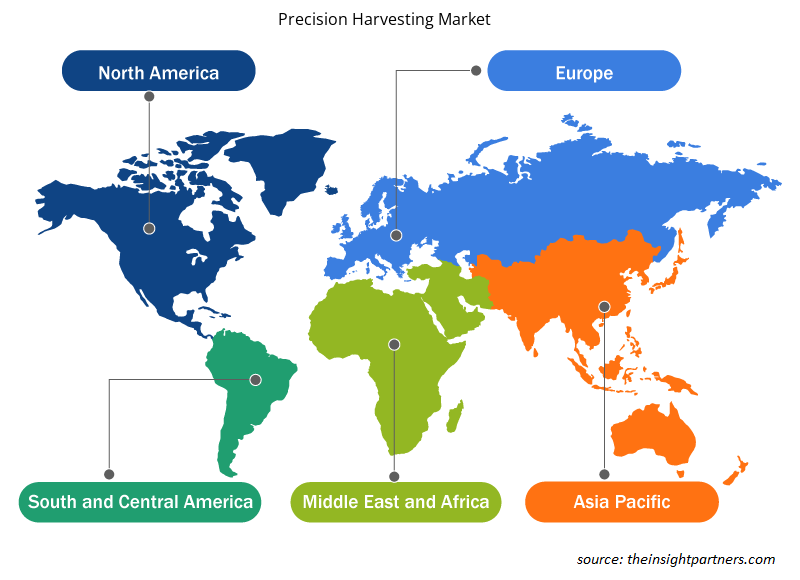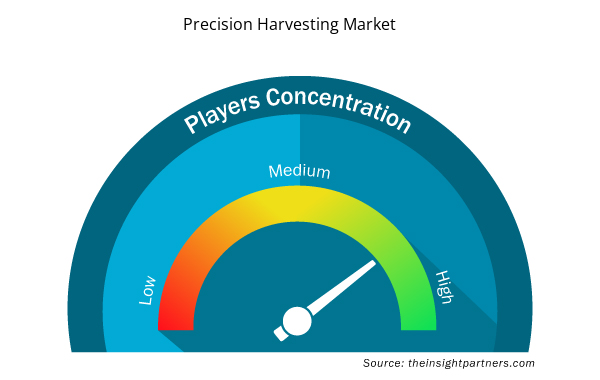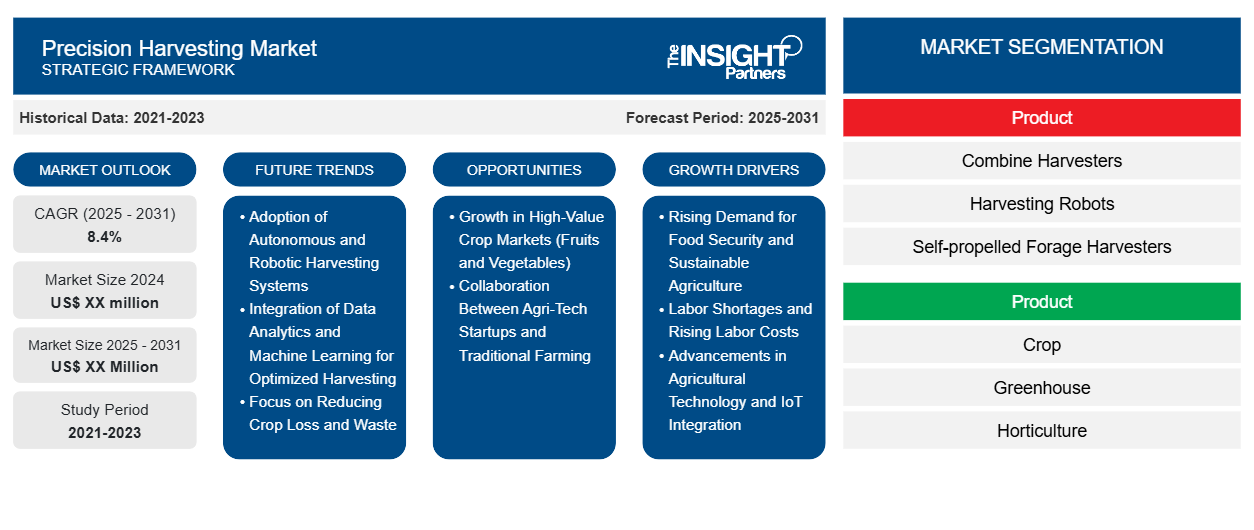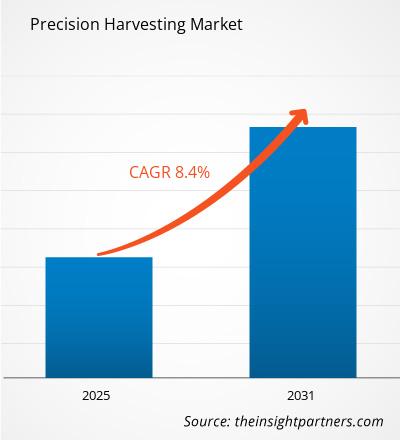Es wird erwartet, dass der Markt für Präzisionserntetechnik von 2024 bis 2031 eine durchschnittliche jährliche Wachstumsrate (CAGR) von 8,4 % verzeichnet, wobei die Marktgröße von XX Millionen US-Dollar im Jahr 2024 auf XX Millionen US-Dollar im Jahr 2031 anwachsen wird.CAGR of 8.4% from 2024 to 2031, with a market size expanding from US$ XX million in 2024 to US$ XX Million by 2031.
Der Bericht ist segmentiert nach Produkt (Mähdrescher, Ernteroboter, selbstfahrende Feldhäcksler), Produkt (Ernte, Gewächshaus, Gartenbau, Sonstiges) und Angebot (Hardware, Software, Dienstleistungen). Die globale Analyse ist weiter auf regionaler Ebene und in den wichtigsten Ländern aufgeschlüsselt. Der Bericht bietet den Wert in USD für die oben genannte Analyse und Segmente.USD for the above analysis and segments
Zweck des Berichts
Der Bericht „Precision Harvesting Market“ von The Insight Partners soll die aktuelle Landschaft und das zukünftige Wachstum sowie die wichtigsten treibenden Faktoren, Herausforderungen und Chancen beschreiben. Dies wird verschiedenen Geschäftspartnern Einblicke geben, wie zum Beispiel:
- Technologieanbieter/-hersteller: Um die sich entwickelnde Marktdynamik zu verstehen und die potenziellen Wachstumschancen zu kennen, damit sie fundierte strategische Entscheidungen treffen können.
- Investoren: Durchführung einer umfassenden Trendanalyse hinsichtlich der Marktwachstumsrate, der finanziellen Marktprognosen und der Chancen entlang der Wertschöpfungskette.
- Regulierungsbehörden: Zur Regulierung von Richtlinien und Überwachungsaktivitäten auf dem Markt mit dem Ziel, Missbrauch zu minimieren, das Vertrauen der Anleger zu bewahren und die Integrität und Stabilität des Marktes aufrechtzuerhalten.
Marktsegmentierung für Präzisionsernte
Produkt
- Mähdrescher
- Ernteroboter
- Selbstfahrende Feldhäcksler
Produkt
- Ernte
- Gewächshaus
- Gartenbau
- Sonstiges
Angebot
- Hardware
- Software
- Dienstleistungen
Geographie
- Nordamerika
- Europa
- Asien-Pazifik
- Süd- und Mittelamerika
- Naher Osten und Afrika
Passen Sie diesen Bericht Ihren Anforderungen an
Sie erhalten kostenlose Anpassungen an jedem Bericht, einschließlich Teilen dieses Berichts oder einer Analyse auf Länderebene, eines Excel-Datenpakets sowie tolle Angebote und Rabatte für Start-ups und Universitäten.
- Holen Sie sich die wichtigsten Markttrends aus diesem Bericht.Dieses KOSTENLOSE Beispiel umfasst eine Datenanalyse von Markttrends bis hin zu Schätzungen und Prognosen.
Wachstumstreiber für den Präzisionserntemarkt
- Steigende Nachfrage nach Ernährungssicherheit und nachhaltiger Landwirtschaft: Die wachsende Weltbevölkerung und die steigende Nachfrage nach Nahrungsmitteln erfordern effizientere und nachhaltigere landwirtschaftliche Praktiken. Präzisionserntetechnologien wie automatisierte Erntesysteme und Sensoren tragen dazu bei, Ernteerträge zu optimieren, Abfall zu reduzieren und die Umweltbelastung zu minimieren. Diese Fortschritte tragen zur Verbesserung der Ernährungssicherheit bei und gewährleisten gleichzeitig nachhaltige landwirtschaftliche Praktiken, was die Nachfrage nach Präzisionserntelösungen steigert.
- Arbeitskräftemangel und steigende Arbeitskosten: Arbeitskräftemangel, insbesondere in der Landwirtschaft, in Verbindung mit steigenden Arbeitskosten sind die Hauptgründe für die Einführung von Präzisionserntetechnologien. Automatisierte Erntesysteme wie Ernteroboter können die Abhängigkeit von menschlicher Arbeitskraft verringern und gleichzeitig die Effizienz steigern und die Betriebskosten senken. Während Landwirte nach Möglichkeiten suchen, Arbeitsprobleme zu lösen, bieten Präzisionserntegeräte eine wirksame Lösung, um die Abhängigkeit von Arbeitskräften zu verringern und die Produktivität aufrechtzuerhalten.
- Fortschritte in der Agrartechnologie und IoT-Integration: Die Integration von IoT-Geräten (Internet of Things), maschinellem Lernen und KI-Technologien in die Landwirtschaft revolutioniert die Präzisionsernte. Diese Fortschritte ermöglichen es Landwirten, den Zustand der Pflanzen, die Bodenbeschaffenheit und die Erntezeitpläne in Echtzeit zu überwachen. Da die Technologie zugänglicher und kostengünstiger wird, nimmt die Einführung von Präzisionserntesystemen zu, sodass Landwirte datengesteuerte Entscheidungen treffen und den Ernteprozess optimieren können.
Zukünftige Trends im Markt für Präzisionsernte
- Einführung autonomer und robotergestützter Erntesysteme: Der Trend zur Automatisierung in der Landwirtschaft verändert den Markt für Präzisionsernte. Autonome und robotergestützte Erntesysteme erfreuen sich aufgrund ihrer Fähigkeit, effizient und autonom auf den Feldern zu arbeiten, zunehmender Beliebtheit. Diese Systeme verwenden fortschrittliche Sensoren und KI-Algorithmen, um reife Pflanzen zu identifizieren, sie präzise zu ernten und ohne menschliches Eingreifen zu arbeiten. Dieser Trend dürfte sich fortsetzen, da Roboterlösungen ihre Funktionalität, Geschwindigkeit und Kosteneffizienz verbessern.
- Integration von Datenanalyse und maschinellem Lernen für eine optimierte Ernte: Datenanalyse und maschinelles Lernen spielen auf dem Markt für Präzisionsernte eine wesentliche Rolle. Durch das Sammeln und Analysieren von Daten von Sensoren und IoT-Geräten können Landwirte Erkenntnisse über den besten Erntezeitpunkt, den optimalen Ernteertrag und mögliche Verbesserungsbereiche gewinnen. Die Integration von Algorithmen für maschinelles Lernen hilft dabei, die Erntebedingungen vorherzusagen und sicherzustellen, dass die Pflanzen zum idealen Zeitpunkt geerntet werden, was zu einer verbesserten Produktivität und weniger Abfall führt.
- Fokus auf die Reduzierung von Ernteverlusten und -abfällen: Präzisionserntetechnologien konzentrieren sich zunehmend auf die Reduzierung von Ernteverlusten und -abfällen, ein bedeutender Trend auf dem Markt. Mithilfe fortschrittlicher Maschinen, die selektiv nur reife Pflanzen ernten und unreife zurücklassen können, werden Abfälle minimiert und die Produktivität maximiert. Dies ist besonders wichtig bei hochwertigen Pflanzen wie Obst und Gemüse, bei denen eine Über- oder Unterernte zu erheblichen Verlusten führen kann. Der Trend zur Reduzierung von Lebensmittelabfällen durch präzise Ernte wird zu einem kritischen Aspekt des Marktes.
Marktchancen für Präzisionsernte
- Wachstum in Märkten für hochwertige Nutzpflanzen (Obst und Gemüse): Die Präzisionsernte bietet eine vielversprechende Chance in Märkten für hochwertige Nutzpflanzen wie Obst und Gemüse. Diese Nutzpflanzen erfordern oft eine sorgfältigere Handhabung und eine präzise Ernte, um ihre Qualität zu erhalten. Durch den Einsatz fortschrittlicher Technologien wie Ernteroboter und KI-gestützter Sortiersysteme können Landwirte den Ertrag und die Qualität dieser Nutzpflanzen verbessern und gleichzeitig den Abfall minimieren. Da die Nachfrage nach frischen Produkten weltweit weiter steigt, wird die Präzisionsernte eine entscheidende Rolle bei der Gewährleistung optimaler Ernten dieser Nutzpflanzen spielen.
- Zusammenarbeit zwischen Agri-Tech-Startups und traditioneller Landwirtschaft: Es gibt immer mehr Möglichkeiten für die Zusammenarbeit zwischen innovativen Agri-Tech-Startups und traditionellen landwirtschaftlichen Betrieben, um die Einführung von Präzisionserntetechnologien voranzutreiben. Startups entwickeln neue und erschwingliche Technologien, während traditionelle Bauernhöfe fundiertes landwirtschaftliches Wissen und Marktzugang einbringen. Durch die Zusammenarbeit können beide die Integration von Präzisionserntelösungen beschleunigen und so ein nachhaltigeres und effizienteres landwirtschaftliches Ökosystem schaffen. Diese Zusammenarbeit dürfte eine wichtige Chance für den Markt sein, während er wächst und reift.
Regionale Einblicke in den Präzisionserntemarkt
Die regionalen Trends und Faktoren, die den Markt für Präzisionsernte im Prognosezeitraum beeinflussen, wurden von den Analysten von Insight Partners ausführlich erläutert. In diesem Abschnitt werden auch die Marktsegmente und die Geografie für Präzisionsernte in Nordamerika, Europa, im asiatisch-pazifischen Raum, im Nahen Osten und Afrika sowie in Süd- und Mittelamerika erörtert.

- Erhalten Sie regionale Daten zum Markt für Präzisionserntemaschinen
Umfang des Marktberichts zur Präzisionsernte
| Berichtsattribut | Details |
|---|---|
| Marktgröße im Jahr 2024 | XX Millionen US-Dollar |
| Marktgröße bis 2031 | XX Millionen US-Dollar |
| Globale CAGR (2025 - 2031) | 8,4 % |
| Historische Daten | 2021-2023 |
| Prognosezeitraum | 2025–2031 |
| Abgedeckte Segmente | Nach Produkt
|
| Abgedeckte Regionen und Länder | Nordamerika
|
| Marktführer und wichtige Unternehmensprofile |
|
Dichte der Marktteilnehmer für Präzisionsernte: Die Auswirkungen auf die Geschäftsdynamik verstehen
Der Markt für Präzisionsernte wächst rasant, angetrieben durch die steigende Nachfrage der Endnutzer aufgrund von Faktoren wie sich entwickelnden Verbraucherpräferenzen, technologischen Fortschritten und einem größeren Bewusstsein für die Vorteile des Produkts. Mit steigender Nachfrage erweitern Unternehmen ihr Angebot, entwickeln Innovationen, um die Bedürfnisse der Verbraucher zu erfüllen, und nutzen neue Trends, was das Marktwachstum weiter ankurbelt.
Die Marktteilnehmerdichte bezieht sich auf die Verteilung der Firmen oder Unternehmen, die in einem bestimmten Markt oder einer bestimmten Branche tätig sind. Sie gibt an, wie viele Wettbewerber (Marktteilnehmer) in einem bestimmten Marktraum im Verhältnis zu seiner Größe oder seinem gesamten Marktwert präsent sind.
Die wichtigsten auf dem Markt für Präzisionsernte tätige Unternehmen sind:
- Führende Agrartechnologie
- AGCO Corporation
- AgJunction
- CLAAS KGaA mbH
- Deere und Company
Haftungsausschluss : Die oben aufgeführten Unternehmen sind nicht in einer bestimmten Reihenfolge aufgeführt.

- Überblick über die wichtigsten Akteure auf dem Markt für Präzisionsernte
Wichtige Verkaufsargumente
- Umfassende Abdeckung: Der Bericht deckt die Analyse von Produkten, Dienstleistungen, Typen und Endbenutzern des Präzisionsernte-Marktes umfassend ab und bietet einen ganzheitlichen Überblick.
- Expertenanalyse: Der Bericht basiert auf dem umfassenden Verständnis von Branchenexperten und Analysten.
- Aktuelle Informationen: Der Bericht stellt durch die Abdeckung aktueller Informationen und Datentrends Geschäftsrelevanz sicher.
- Anpassungsoptionen: Dieser Bericht kann angepasst werden, um spezifische Kundenanforderungen zu erfüllen und die Geschäftsstrategien optimal anzupassen.
Der Forschungsbericht zum Markt für Präzisionsernte kann daher dabei helfen, die Branchensituation und Wachstumsaussichten zu entschlüsseln und zu verstehen. Obwohl es einige berechtigte Bedenken geben kann, überwiegen die allgemeinen Vorteile dieses Berichts tendenziell die Nachteile.
- Historische Analyse (2 Jahre), Basisjahr, Prognose (7 Jahre) mit CAGR
- PEST- und SWOT-Analyse
- Marktgröße Wert/Volumen – Global, Regional, Land
- Branche und Wettbewerbsumfeld
- Excel-Datensatz



Report Coverage
Revenue forecast, Company Analysis, Industry landscape, Growth factors, and Trends

Segment Covered
This text is related
to segments covered.

Regional Scope
North America, Europe, Asia Pacific, Middle East & Africa, South & Central America

Country Scope
This text is related
to country scope.
Häufig gestellte Fragen
Some of the customization options available based on the request are an additional 3-5 company profiles and country-specific analysis of 3-5 countries of your choice. Customizations are to be requested/discussed before making final order confirmation# as our team would review the same and check the feasibility
The report can be delivered in PDF/PPT format; we can also share excel dataset based on the request
Artificial intelligence and machine learning integration to play a significant role in the global precision harvesting market in the coming years
Increasing agricultural labor costs and growing demand for food security are the major factors driving the precision harvesting market
The Precision Harvesting Market is estimated to witness a CAGR of 8.4% from 2023 to 2031
Trends and growth analysis reports related to Electronics and Semiconductor : READ MORE..
1. Ag Leader Technology
2. AGCO Corporation
3. AgJunction
4. CLAAS KGaA mbH
5. Deere and Company
6. DICKEY-john
7. PELLENC S.A.S
8. Raven Industries, Inc.
9. TEEJET TECHNOLOGIES
10. Trimble Inc.
The Insight Partners performs research in 4 major stages: Data Collection & Secondary Research, Primary Research, Data Analysis and Data Triangulation & Final Review.
- Data Collection and Secondary Research:
As a market research and consulting firm operating from a decade, we have published and advised several client across the globe. First step for any study will start with an assessment of currently available data and insights from existing reports. Further, historical and current market information is collected from Investor Presentations, Annual Reports, SEC Filings, etc., and other information related to company’s performance and market positioning are gathered from Paid Databases (Factiva, Hoovers, and Reuters) and various other publications available in public domain.
Several associations trade associates, technical forums, institutes, societies and organization are accessed to gain technical as well as market related insights through their publications such as research papers, blogs and press releases related to the studies are referred to get cues about the market. Further, white papers, journals, magazines, and other news articles published in last 3 years are scrutinized and analyzed to understand the current market trends.
- Primary Research:
The primarily interview analysis comprise of data obtained from industry participants interview and answers to survey questions gathered by in-house primary team.
For primary research, interviews are conducted with industry experts/CEOs/Marketing Managers/VPs/Subject Matter Experts from both demand and supply side to get a 360-degree view of the market. The primary team conducts several interviews based on the complexity of the markets to understand the various market trends and dynamics which makes research more credible and precise.
A typical research interview fulfils the following functions:
- Provides first-hand information on the market size, market trends, growth trends, competitive landscape, and outlook
- Validates and strengthens in-house secondary research findings
- Develops the analysis team’s expertise and market understanding
Primary research involves email interactions and telephone interviews for each market, category, segment, and sub-segment across geographies. The participants who typically take part in such a process include, but are not limited to:
- Industry participants: VPs, business development managers, market intelligence managers and national sales managers
- Outside experts: Valuation experts, research analysts and key opinion leaders specializing in the electronics and semiconductor industry.
Below is the breakup of our primary respondents by company, designation, and region:

Once we receive the confirmation from primary research sources or primary respondents, we finalize the base year market estimation and forecast the data as per the macroeconomic and microeconomic factors assessed during data collection.
- Data Analysis:
Once data is validated through both secondary as well as primary respondents, we finalize the market estimations by hypothesis formulation and factor analysis at regional and country level.
- Macro-Economic Factor Analysis:
We analyse macroeconomic indicators such the gross domestic product (GDP), increase in the demand for goods and services across industries, technological advancement, regional economic growth, governmental policies, the influence of COVID-19, PEST analysis, and other aspects. This analysis aids in setting benchmarks for various nations/regions and approximating market splits. Additionally, the general trend of the aforementioned components aid in determining the market's development possibilities.
- Country Level Data:
Various factors that are especially aligned to the country are taken into account to determine the market size for a certain area and country, including the presence of vendors, such as headquarters and offices, the country's GDP, demand patterns, and industry growth. To comprehend the market dynamics for the nation, a number of growth variables, inhibitors, application areas, and current market trends are researched. The aforementioned elements aid in determining the country's overall market's growth potential.
- Company Profile:
The “Table of Contents” is formulated by listing and analyzing more than 25 - 30 companies operating in the market ecosystem across geographies. However, we profile only 10 companies as a standard practice in our syndicate reports. These 10 companies comprise leading, emerging, and regional players. Nonetheless, our analysis is not restricted to the 10 listed companies, we also analyze other companies present in the market to develop a holistic view and understand the prevailing trends. The “Company Profiles” section in the report covers key facts, business description, products & services, financial information, SWOT analysis, and key developments. The financial information presented is extracted from the annual reports and official documents of the publicly listed companies. Upon collecting the information for the sections of respective companies, we verify them via various primary sources and then compile the data in respective company profiles. The company level information helps us in deriving the base number as well as in forecasting the market size.
- Developing Base Number:
Aggregation of sales statistics (2020-2022) and macro-economic factor, and other secondary and primary research insights are utilized to arrive at base number and related market shares for 2022. The data gaps are identified in this step and relevant market data is analyzed, collected from paid primary interviews or databases. On finalizing the base year market size, forecasts are developed on the basis of macro-economic, industry and market growth factors and company level analysis.
- Data Triangulation and Final Review:
The market findings and base year market size calculations are validated from supply as well as demand side. Demand side validations are based on macro-economic factor analysis and benchmarks for respective regions and countries. In case of supply side validations, revenues of major companies are estimated (in case not available) based on industry benchmark, approximate number of employees, product portfolio, and primary interviews revenues are gathered. Further revenue from target product/service segment is assessed to avoid overshooting of market statistics. In case of heavy deviations between supply and demand side values, all thes steps are repeated to achieve synchronization.
We follow an iterative model, wherein we share our research findings with Subject Matter Experts (SME’s) and Key Opinion Leaders (KOLs) until consensus view of the market is not formulated – this model negates any drastic deviation in the opinions of experts. Only validated and universally acceptable research findings are quoted in our reports.
We have important check points that we use to validate our research findings – which we call – data triangulation, where we validate the information, we generate from secondary sources with primary interviews and then we re-validate with our internal data bases and Subject matter experts. This comprehensive model enables us to deliver high quality, reliable data in shortest possible time.


 Holen Sie sich ein kostenloses Muster für diesen Bericht
Holen Sie sich ein kostenloses Muster für diesen Bericht